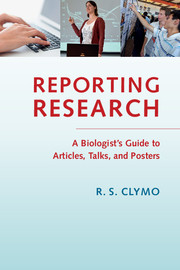5 - Style in writing
Published online by Cambridge University Press: 05 October 2014
Summary
Writing style is recognisable by the choice and arrangement of words, and by the physical layout (‘format’) of the work. The style of an instruction manual is different from that of a novel or a play, and their styles differ from that used in a newspaper, in a legal document or in poetry. Scientific style is closely linked to the main objective of scientific writing: to convey information as clearly and simply as possible. Do this, and you may one day deserve the obituarist’s note on the Nobel Prize winner Professor Sir Bernard Katz, whose first language was not English, that “His prose was simple, straightforward and unpretentious … Every new entrant [to the field of neural physiology] should read his work from beginning to end.”
Style may be acquired by wide reading of the works of those generally held to be ‘good’ stylists, or by learning rules (and exceptions). Be aware, however, that many scientists and almost all editors hold strong views about style, and many - perhaps all - would disagree with at least some of what follows in this chapter.
Swift had a pithy view of good style: “proper words in proper places”. (He used ‘proper’ in its older sense of suitable or appropriate.) More helpful perhaps is the advice of Matthew Arnold: that the secret of good writing lies in having something to say and saying it clearly.
- Type
- Chapter
- Information
- Reporting ResearchA Biologist's Guide to Articles, Talks, and Posters, pp. 119 - 156Publisher: Cambridge University PressPrint publication year: 2014



